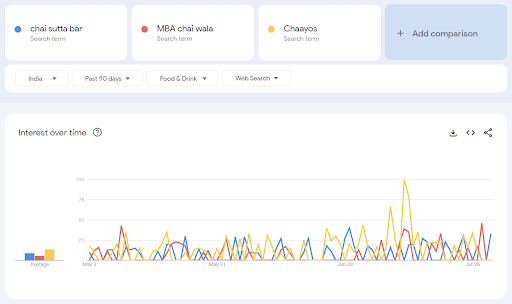Quick summary: Discover how to turn your passion for tea into a successful online business. This guide covers the basics to sell tea online like sourcing, setting up an online store, and effective marketing strategies to help you thrive in the competitive world of online tea sales. Get ready to brew success from home!
Are you eager to share your love for tea and turn it into a profitable online venture? Hence, selling tea online is not only a delightful journey but also a lucrative one.
Let’s spill the secrets to sourcing the finest teas, setting up an irresistible online store, and brewing successful strategies. So, grab your favourite cuppa, and let’s embark on the exciting adventure of selling tea online!
Let’s get started!
How to start selling tea online?
Selling tea online can be a rewarding business venture, combining your passion for tea with the power of eCommerce. Whether you’re a tea connoisseur or a budding entrepreneur, follow these steps to launch your own online tea business successfully:
1. Identify target audience & niche
Determine your target market and the niche you want to serve. Focus on specific types of tea (e.g., organic, rare blends, herbal), and tailor your branding and marketing efforts to appeal to your ideal customers.
Related read: How to define and reach your target audience as an eCommerce business
2. Source high-quality tea products

To create an exceptional tea business, it’s crucial to source high-quality tea products. Collaborate with reputable tea suppliers or wholesalers who can provide the finest teas.
Make sure you prioritise freshness, quality, and ethical sourcing practices when choosing a supplier. This ensures your customers are delighted with every sip of tea they enjoy.
By establishing strong partnerships and maintaining a focus on excellence, your tea business is bound to thrive and gain a loyal following of tea enthusiasts.
3. Create your own eCommerce website
Establish your brand supremacy by creating your own eCommerce website. Basically, with D2C tech platforms like Instamojo, you can get an online store with a clean and aesthetically pleasing layout.
So, incorporate tea-related visuals, use a soothing colour palette, and ensure easy navigation for a delightful shopping experience.
You can start an eCommerce business with little to no money.
Moreover, let’s dive into the inspiring story of Namhya Foods! They kickstarted their business journey with Instamojo; hence, they soared to success! Additionally, as a small business owner, Ridhima chose Instamojo to start her eCommerce journey.
Today, Namhya Foods stands as a shining example, motivating millions of aspiring nutritionists and food entrepreneurs worldwide. But that’s not all! Moreover, Ridhima’s journey took her to Season 1 of Shark Tank India, where she fearlessly faced the sharks and emerged victorious.
Read other Instamojo sellers who appeared on Shark Tank!
Guess what? She sealed an incredible deal of Rs 50 lakh with 10% equity! Therefore, now, Namhya Foods boasts a monthly sales record of Rs 40 lakh and has distribution centres in UAE, UK, US, and Canada!
We’re beyond proud to be a part of Ridhima’s incredible journey. So, if you’re dreaming big, Instamojo is here to support you every step of the way. Let’s turn your business dreams into reality!
Start your online store for free
4. Secure payment gateways to sell tea online
Integrate payment gateways like PayPal, Stripe, or Square to facilitate smooth and secure customer transactions.
5. Implement efficient shipping methods
Offering a variety of shipping options to accommodate different customer needs is essential. Furthermore, consider providing free shipping for larger orders or loyalty program members. In addition, optimizing your shipping process will ensure timely delivery.
Related read: 8 shipping factors to consider when choosing a courier partner
Do I need FSSAI and FDA approval to sell tea online?
When selling tea online, certifications and understanding regulations are crucial for customer trust and product quality. Let’s explore the key certifications required and various tea types.
Understanding FSSAI (Food Safety and Standards Authority of India)
Complying with FSSAI regulations is essential for Indian tea businesses. Notably, small-scale ventures need registration, while larger ones require a licence. Furthermore, adherence ensures safety, quality, and proper labelling.
Apply for your licence here and ensure that your food business meets all the necessary safety and quality standards, gaining the trust of your customers and authorities alike.
Understanding FDA (U.S. Food and Drug Administration) Regulations
Do you want to expand your tea business internationally after looking at the demand for Indian tea globally? If yes, then selling tea online in the United States requires an understanding of FDA regulations.
The FDA regulates tea as a food product; in addition, certain blends or additives may have specific requirements. Consequently, it is essential to research and seek expert advice for better compliance.
Note: FDA regulations apply when selling tea to US customers or if your tea products include additives requiring FDA approval.
Is selling tea online profitable?
Sure thing! Selling tea online can be a real money-maker!
Just look at these numbers by the India Brand Equity Foundation
- India: Top tea-consuming nation, 80% tea production for domestic consumers.
- Northern India: 83% annual tea output, led by Assam and West Bengal.
- Southern India: 17% tea production, with Tamil Nadu, Kerala, and Karnataka as top producers.
- FY 2021-22: India produced 1,344.4 million kg of tea
The numbers prove the value of India’s tea market and the potential success of an online tea business. Here are more advantages of having an online business over a physical storefront:
- To begin with, reach tea lovers worldwide 24/7 with cost-effective online shops.
- Furthermore, there are no geographical restrictions for your “shop.”
- In addition, you can directly interact with customers, saving on overhead costs.
- Additionally, online platforms offer valuable insights and niche market exploration with cool marketing options.
Just remember, quality products, killer marketing, top-notch customer service, and staying adaptable are the keys to rocking the online tea business.
Related read: Future-proofing your eCommerce business: Is D2C the way to go in 2023?
The various types of tea that you can sell online
Here are the most popular types of tea that you can sell online and gain profits:
- Black Tea: Known for its bold flavour, black tea is fully oxidised, offering a deep amber to dark brown liquor. Varieties include English Breakfast, Earl Grey, Darjeeling, and Assam.
- Green Tea: Minimally oxidised, green tea preserves its green colour and fresh flavour. Popular types include Sencha, Dragonwell, and Matcha.
- White Tea: Made from young buds and leaves, white tea has a delicate and subtle flavour with a pale liquor. Examples include Silver Needle and Bai Mu Dan.
- Oolong Tea: Partially oxidised, oolong tea boasts a range of flavours from floral to toasty. Notable varieties include Tie Guan Yin and Da Hong Pao.
- Herbal Tea: Brewed from herbs, fruits, and spices, herbal teas offer diverse flavours and potential health benefits. Examples include chamomile, peppermint, and hibiscus.
- Pu-erh Tea: Fermented and aged, Pu-erh tea has an earthy, mellow taste, often compressed into cakes or bricks.
- Yellow Tea: A rare type with a slow oxidation process, offering a delicate flavour and a slightly yellowish liquor.
- Jasmine Tea: Scented with jasmine blossoms, this tea is soothing and aromatic.
- Chai Tea: A spiced blend from India, often made with black tea, milk, and warming spices.
- Yerba Mate: A South American beverage made from Ilex paraguariensis leaves, providing natural caffeine and herbal flavour.
- Genmaicha: Japanese green tea blended with toasted rice, offering a nutty taste.
- Herbal Blends: Combining various herbs, flowers, and fruits creates unique and flavorful infusions.
- Blooming Tea (Artisan Tea): Hand-tied tea bundles unfurl into visually stunning displays when steeped.
- Dark Tea (Hei Cha): A fermented Chinese tea variety with unique flavours and ageing potential.
- Hojicha: A roasted Japanese green tea with a reddish-brown colour and toasty flavour.
How much do you need to invest to start this business?
When it comes to investment, it is essential to note that this factor depends on the size, nature, and marketing channels for the tea business.
The investment required for starting a tea-selling business can also vary based on your scale and plans.
Key expenses include:
- Tea inventory
- Packaging materials
- eCommerce platform
- Marketing and branding
- Certifications
- Shipping
- Workspace
Therefore, you can create a detailed business plan to estimate your specific costs and ensure a successful tea business launch.
How should you price your tea?
Did you know that players like Chai Sutta Bar, MBA Chai Wala, and Chayos have significantly impacted the online tea market?
Chai Sutta Bar has gained popularity with its unique and trendy approach to serving tea, attracting a young and urban audience.
MBA Chai Wala has leveraged social media marketing and brand storytelling to connect with millennials and students.
Chayos, on the other hand, has focused on offering a wide variety of tea blends and a premium tea experience, catering to a more discerning customer base.
For comparison, here is a Google Trend screenshot showing a line chart showing the domination of online tea ventures competition on the web:

Pricing your tea appropriately is crucial for the success of your tea-selling business.
It’s a delicate balance, considering factors for competitive, profitable pricing that appeals to your target market.
Here are 8 essential steps to help you determine how to price your tea:
- Calculate all costs involved, including sourcing, packaging, and overheads.
- Set a competitive profit margin based on your business goals.
- Research competitors’ prices and offer unique value to customers.
- Tailor pricing to match your target market’s preferences and budget.
- Invest in attractive packaging to justify higher prices for premium teas.
- Differentiate wholesale and retail pricing if applicable.
- Adjust pricing for seasonal variations and market trends.
- Lastly, monitor sales data and customer feedback, adapting pricing as needed.
Did you know?
As per Statista, the tea market is projected to reach a volume of 1.28 billion kg by 2028, with an expected growth rate of 1.5% in 2024.
How to sell tea online from home?
Selling tea from home can be rewarding, but it requires careful planning and execution.
Therefore, here is a comprehensive list of pointers on how to sell tea from home, considering the key aspects:
- Legal considerations: Register your business and obtain the necessary permits.
- Business plan: Outline your vision, target market, and growth strategy.
- Tea selection: Curate a diverse collection of high-quality teas.
- Equipment: Gather essential tea-making tools and accessories including teapots, kettles, infusers, cups, filters, timers, scales, purifiers, storage, thermometers (optional), and trays (optional).
- Sourcing tea: Establish reliable suppliers or partner with tea estates.
- Packaging and branding: Create an appealing brand identity and packaging.
- Online presence: Build a user-friendly website for easy purchasing.
- Local marketing: Utilise social media and collaborate with influencers.
- Customer service: Offer excellent support and personalised assistance.
- Shipping and packaging: Ensure secure packaging and reliable shipping partners.
- Pricing: Set competitive and profitable prices through market research.
- Quality control: Maintain consistent tea quality through rigorous measures like frequent taste tests with focus groups
- Educational content: Build a reputation by providing informative content about tea types and brewing methods.
- Customer reviews and feedback: Lastly, encourage reviews for trust-building and improvement.
How to sell tea on social media?
Selling on social media platforms empowers you to connect with potential customers, showcase products, and drive sales.
Let’s explore how to effectively sell on some of the most popular social media platforms:
1. Sell on Instagram
- Business Account: Get insights and promotions tools.
- Visual Storytelling: Showcase teas with images and videos.
- Instagram Shopping: Tag products for direct purchases.
- Engage with Followers: Respond promptly to build connections.
Here is a comprehensive guide on selling on Instagram
2. Sell on Facebook
- Facebook Shop: Sell teas on your business page directly.
- Engaging Content: Post info and tips about tea.
- Facebook Groups: Interact and promote to a targeted audience.
For a better understanding, you can also check this guide discussing how to sell on Facebook.
3. Sell on Twitter
- Tweet with Purpose: Share tea updates, promotions, and offers.
- Relevant Hashtags: Use popular tea hashtags for visibility.
- Engage and Respond: Interact with followers, answer inquiries, and provide tea info.
Related Search: Twitter tests out eCommerce features
4. Sell on Pinterest
- Visual Pins: Showcase stunning teas to inspire customers.
- Rich Pins: Display accurate pricing and availability info.
- Drive Traffic: Include store links in pin descriptions.
Check out more tips on how to sell on Pinterest.
5. Sell on YouTube
- Informative Videos: Share educational tea content – types, brewing, and health benefits.
- Product Reviews and Tastings: Conduct authentic tastings to build credibility.
- Include Call-to-Action: Encourage website visits with video links.
Related Search: How to sell on Youtube with no money
6. Sell on LinkedIn
- Network with Tea Pros: First of all, connect with enthusiasts, influencers, and pros to expand your reach.
- Share Insights: Now, publish articles on trends, health benefits, and news to establish expertise.
- Explore Business: Lastly, utilise LinkedIn for partnerships, collaborations, and wholesale prospects.
Related Search: Use LinkedIn for better sales conversations
Launch your online tea business with Instamojo
Ready to launch your online tea business with a hosted eCommerce solution? Instamojo has you covered! Because it’s a user-friendly eCommerce solution for your D2C tea brand.
But wait, there’s more!
Instamojo offers pro-level marketing tools: discount coupons, promotions, and social media sharing.
Best part? Instamojo boosts your tea store’s search engine-friendliness for increased organic traffic.
So, what are you waiting for? Start your D2C tea brand today with Instamojo and join tea lovers from all around the world.
Let’s sip success together!


